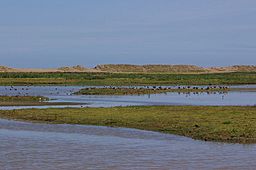Cley Marshes facts for kids
Quick facts for kids NWT Cley Marshes |
|
| Nature reserve | |
|
Looking north across the reserve
|
|
| Country | England |
|---|---|
| Region | East of England |
| County | Norfolk |
| Coordinates | 52°57′32″N 1°03′22″E / 52.959°N 1.056°E |
| Biome | Reed bed |
| Animal | Eurasian bittern, Pied avocet, Western marsh harrier |
| Founded | 1926 |
| For public | Open year round |
| Protection status | |
Cley Marshes is a very special nature reserve in Norfolk, England. It covers about 176 hectares (that's like 435 football fields!). You can find it right on the North Sea coast, near the village of Cley next the Sea.
This amazing place became a protected area way back in 1926. This makes it the oldest reserve managed by the Norfolk Wildlife Trust (NWT). The NWT is actually the oldest local Wildlife Trust in the whole United Kingdom!
Cley Marshes protects important habitats like tall reed beds, freshwater marsh, pools, and wet wet meadows. It's super important for birds, so it has many special protections. These include being a Site of Special Scientific Interest (SSSI) and a Ramsar Site.
The reserve is a vital home for some rare birds that breed in the UK. Western marsh harriers are one example. It's also a huge stop-off point for birds during migration. Many birds also spend the winter here. You can also find rare invertebrates (like insects) and plants that love this coastal environment.
Contents
Exploring Cley Marshes
Cley Marshes has a fantastic visitor centre that's very kind to the environment. There are plans to make the reserve even bigger. They want to buy more land nearby and make the visitor facilities even better.
Eco-Friendly Visitor Centre
The visitor centre at Cley Marshes is built with environmentally friendly ideas. Its roof is covered with living sedum plants. This helps keep the building cool and blends it into nature. Rainwater is collected from the roof to be used again. The building also uses less energy thanks to solar water heating, wind turbines, and geothermal heat pumps.
This amazing building has won several awards. One award was the Emirates Glass LEAF architectural award for its great sustainability.
Meet the Wardens
The Cley Marshes reserve has a long and interesting history. For most of its history, it has had only three wardens. And guess what? They are all from the same family!
- Robert Bishop was the first warden, from 1926 to 1937.
- His grandson, Billy, took over from 1937 to 1978.
- Billy's son, Bernard, became warden in 1978 and is still managing the reserve today! That's a lot of family history!
History and Challenges
The area around Cley Marshes has been used by people for a very long time. People were farming here even in prehistoric times. Later, during the Second World War, it was even used as a prisoner of war camp.
The reserve brings many visitors to the area. This helps the local economy in Cley village. However, the marshes face some big challenges.
The Moving Coastline
For hundreds of years, people have built embankments to protect the land and the village from the sea. But the marshes have still been flooded many times. The coastal shingle bank is slowly moving southwards. Also, the sea is slowly coming further inland. This means that, over time, parts of the reserve will likely be lost to the sea.
To prepare for this, new wetlands are being created further inland. These new areas will help make up for the coastal habitats that might be lost in the future.
Images for kids
-
Thomas Telford's recommendations for keeping the access to Cley port open were not implemented.
-
Extant World War II pillbox at end of west bank











